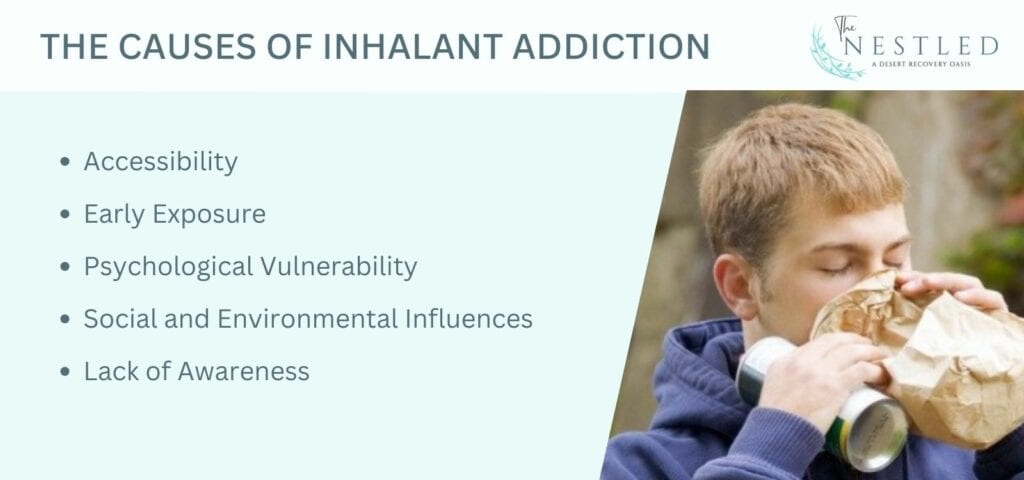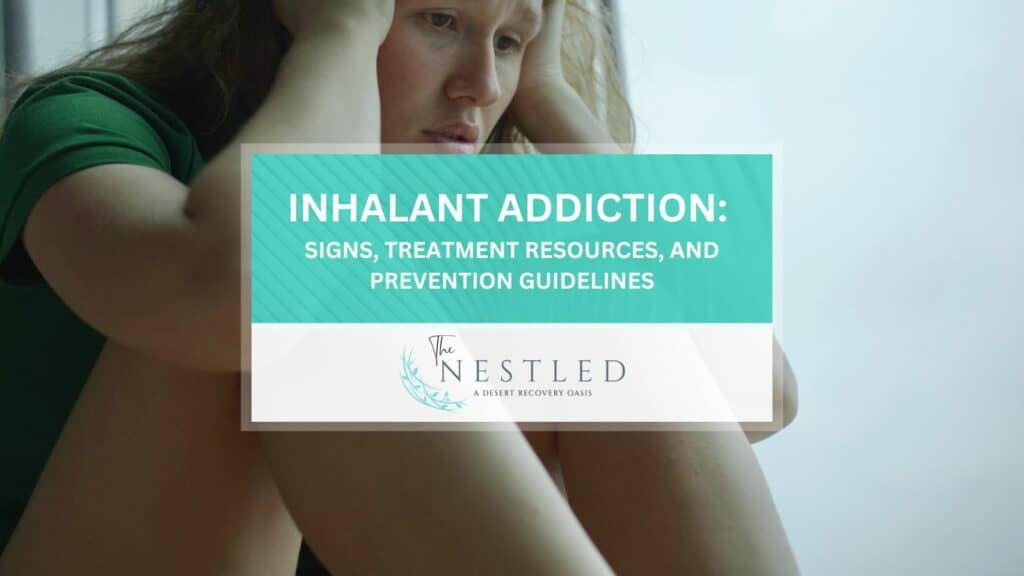Inhalant addiction refers to the compulsive use of volatile substances that produce chemical vapors when inhaled despite their harmful effects. Inhalants induce psychoactive effects and often include household items like glues, aerosols, and solvents. The 2021 National Survey on Drug Use and Health shows that among people aged 12 or older in 2021, 0.8% (or about 2.2 million people) reported using inhalants in the past 12 months. The addictive nature of inhalants is mainly due to their rapid induction of euphoria and hallucinations.
Signs of inhalant addiction include behavioral changes, chemical odor on breath or clothing, frequent runny nose or nosebleeds, confusion, loss of appetite, and mood swings.
Treatment resources for inhalant addiction involve both detoxification and rehabilitation strategies like therapy sessions and supportive aftercare.
Prevention guidelines for inhalant addiction focus on education and awareness. It targets young people to inform them of the risks associated with inhalant use.
What Is Inhalant Addiction?
Inhalant addiction is a compulsive and intense urge to inhale substances that emit vapors despite their adverse effects on the body. These substances usually include everyday household products such as paint thinners, glue, and aerosol sprays.
Individuals with inhalant addiction seek the quick and intense high these vapors provide. The highness comes from the rapid absorption of chemicals through the lungs into the bloodstream. This form of substance abuse not only impairs cognitive and neurological functions but also poses severe health risks.
The addictive nature of inhalants comes from their ability to alter mood and consciousness rapidly. Inhalant addiction is more prevalent and dangerous among adolescents and youth. According to the National Survey on Drug Use and Health 2006 data, up to 1.1 million youths aged 12 to 17 had used inhalants in the past year.
What Are The Signs Of Inhalant Addiction?
Inhalant addiction can present a range of physical and behavioral signs. A 2003 research, ‘Recognition and Prevention of Inhalant Abuse,’ by Carrie E. M.D., and Glenn A. M.D., report that signs of recent inhalant abuse include spots or sores around the mouth, red eyes, rhinorrhea, chemical odor on the breath, and a dazed appearance.
The 3 categories of signs of inhalant addiction are behavioral, physical, and psychological changes.
Behavioral Signs
- Individuals addicted to inhalants continue to use them despite knowledge of the harm they cause.
- Most of the activities of inhalant users center around getting, using, and recovering from the effects of inhalants.
- People addicted to inhalants withdraw from social, recreational, or work activities.
Physical Signs
- There is always evidence of inhalant materials such as rags, bags, or canisters near the addicted individual.
- There are always chemical odors on the breath or clothing of people suffering from inhalant abuse.
- People struggling with inhalant addiction have physical symptoms like sores around the mouth, red or runny eyes and nose, and the appearance of disorientation or stupor.
Psychological Signs
- Individuals addicted to inhalants experience sudden mood swings or aggressive behavior.
- They show noticeable aggressive or depressive states following periods of hyperactivity.
- People addicted to inhalants show signs of confusion or difficulty concentrating.
These signs collectively point toward inhalant addiction. They significantly impact the individual’s health, social interactions, and daily functioning.
What Are The Causes Of Inhalant Addiction?

The causes of inhalant addiction are accessibility, early exposure, psychological vulnerability, social influence, and lack of awareness. These factors work together to influence an individual into getting Inhalant addiction. According to the National Institute on Drug Abuse, many young people inhale the vapors from sources like glues, nail polish remover, lighter fluid, spray paints, deodorant and hair sprays in search of quick intoxication without being aware that using inhalants, even once, can have serious health consequence.
The inhalants most commonly abused include aromatic hydrocarbons, aliphatic hydrocarbons, alkyl halides, and nitrites.
- Accessibility: Inhalants are among the most readily accessible substances due to their presence in a typical household. They include industrial products like paint thinners, glue, and aerosol sprays. Their legal status and low cost contribute significantly to their misuse.
- Early Exposure: Starting substance use at a young age increases the likelihood of developing addiction. Young people often experiment with inhalants because they are easier to obtain than other substances. According to Dinwiddie SHReich et al. ‘s 1991 ‘Solvent abuse as a precursor to intravenous drug abuse’ study, early use of inhalants increases the likelihood of progression to more severe drug-taking behaviors or other problem behaviors.
- Psychological Vulnerability: Individuals with mental health disorders such as depression, anxiety, or a history of trauma are more prone to substance abuse. This increases the risk of using these substances as a coping mechanism to endure psychological distress.
- Social and Environmental Influences: Environments where drug use is widespread or normalized encourage inhalant use. This factor includes influence from peers who use substances or family members who display similar behaviors.
- Lack of Awareness: Many individuals underestimate the risks associated with inhalant use, leading to the misconception that these substances are less harmful. This lack of awareness about the severe health consequences encourages experimentation and regular use.
All these factors combine to create a high risk of addiction. They make inhalants a hazardous class of substances, especially for younger users.
What Are The Effects Of Inhalant Addiction?
The effects of Inhalant addiction are of 3 main ranges: physical, psychological, and cognitive effects. According to an article written by Edward C Jauch, MD, for Medscape on “Inhalant,” most inhalants are central nervous system (CNS) depressants, but they also cause adverse medical effects on almost every organ system. Both short- and long-term toxic effects occur. The following are the effects of inhalant addiction:
What Are The Physical Effects Of Inhalant Addiction?
The 4 ways inhalant addiction affects its victims are;
- Neurological Damage: Chronic use of inhalants damages nerve fibers in the brain, resulting in movement disorders, numbness, and impaired cognitive functions.
- Respiratory Issues: Inhalant addiction often causes respiratory depression, which can lead to suffocation, hypoxia, and, in severe cases, death. It also induces chronic cough, wheezing, and increased susceptibility to respiratory infections.
- Cardiac Effects: Sudden sniffing death syndrome is a fatal outcome of inhalant addiction. The heart fails suddenly after inhalant use due to cardiac arrhythmias.
- Liver and Kidney Damage: long-term inhalant abuse toxifies the liver and kidneys, leading to their failure and long-term health complications.
What Are The Psychological Effects Of Inhalant Addiction?
Inhalant addiction affects the user’s psychology in 2 ways:
- Individuals who have a substance use disorder experience a compulsion to continue using inhalants despite harmful consequences. The urge to use inhalants is a direct effect of the addictive properties of the substances.
- Abusive Inhalant use increases the risk of existing mental health issues. It also causes newly developed mental health issues such as anxiety, depression, and psychosis.
What Are The Cognitive Effects Of Inhalant Addiction?
Two cognitive effects of inhalant addiction are;
- Impaired Cognitive Abilities: Continuous exposure to inhalants leads to deficits in memory, learning, and problem-solving skills.
- Behavioral Changes: Users often exhibit poor judgment, impulsivity, and inability to focus, impacting their social and occupational functioning.
What Are The Treatment Options For Inhalant Addiction?
The treatment resources for inhalant addiction involve detoxification, rehabilitation programs, therapy, support groups, and aftercare. In their 2003 research, ‘Recognition and Prevention of Inhalant Abuse,’ Carrie E. M.D., and Glenn A. M.D., report that treatment of inhalant abuse and dependence involves counseling, strict abstinence by the abuser, and other drug dependency protocols (e.g., 12-step programs, support groups, inpatient and outpatient dependency treatment). The following are the treatment resources for inhalant addiction:
- Detoxification: The first step in treating inhalant addiction is detoxification. It involves the safe removal of chemicals from the body under medical supervision. This process helps manage the addiction’s physical symptoms of withdrawal in a controlled environment to ensure the patient’s safety.
- Inpatient Rehabilitation Programs: Inpatient residential treatment facilities provide structured care, including medical and psychological support. These programs include therapy sessions, medical treatment, and support groups. They focus on healing and skills development for managing life without dependency on inhalants.
- Outpatient Treatment Programs: Outpatient programs allow addicted individuals to live at home while attending therapy and treatment sessions at a clinic or rehabilitation facility. This option suits those with less severe addictions or extensive support networks.
- Cognitive Behavioral Therapy (CBT): CBT helps addicted people identify and change the thought patterns and behaviors associated with inhalant use. It aids in relapse prevention.
- Support Groups: Support groups offer continuous peer support and encouragement vital for long-term recovery. Sharing experiences with people facing similar challenges fosters a sense of community and accountability.
Other treatment resources for inhalant addiction are;
- Family Therapy: Family therapy helps to repair relationships and establish a supportive home environment.
- Educational Programs: Education on the dangers of inhalants and the potential for recovery helps individuals understand the need to make healthy choices.
What Are The Prevention Guidelines For Inhalant Addiction?
The preventive guidelines for inhalant addiction include education, parental involvement, community programs, regulations, and peer education to help prevent inhalant addiction.
- Education: It is essential to educate children and teenagers about the dangers associated with inhalant use. School programs should be designed to raise awareness about the harmful effects of inhalants and help deter their use. Providing factual information about the effects caused by these substances gives young people the knowledge to make informed decisions.
- Parental and Caregiver Involvement: Parents and caregivers play a crucial role in prevention by monitoring their children’s activities and the substances they have access to at home. Removing or securely storing potential inhalants such as glues, aerosols, and solvents reduces access. Also, open lines of communication help parents to intervene early if their children show signs of substance use.
- Community Programs: Community centers and local organizations organize workshops and events that focus on skill-building, healthy living, and alternative recreational activities. These workshops divert attention from substance use. Community support networks also provide a supportive environment for youths, reducing the risk of substance abuse.
- Policy and Regulation: Implementing policies that restrict the sale of inhalable substances to minors reduces the availability of inhalants to young individuals. Making the labels bold and cautious displays discourages the use of these substances as inhalants.
- Peer Education and Leadership Programs: Programs that empower youths to take leadership roles in educating their peers about the risks of drug use help spread prevention messages. Peer-to-peer education helps to cultivate a culture of responsibility and informed choices among young people.
What Are The Types Of Inhalants?
Inhalants are grouped into four main types:
- Volatile Solvents: These include household and industrial products such as paint thinners, gasoline, glue, and nail polish remover.
- Aerosols: Inhalants in aerosol form are found in products such as spray paint, hair spray, and air fresheners.
- Gases: Gaseous inhalants include medical anesthetics (e.g., nitrous oxide or “laughing gas”) and household products like butane or propane.
- Nitrites: Nitrites, also known as “poppers,” are a type of inhalant used primarily as a recreational drug and are typically sold in small bottles labeled as “room deodorizers” or “video head cleaners.”
How Do I Treat Inhalant Overdose?
Treating an inhalant overdose requires immediate medical attention. If someone is experiencing an overdose, call emergency services right away. While waiting for help to arrive, remove the person from the source of inhalant exposure to fresh air.
Ensure that the person’s airway is clear and that they are breathing. Do not induce vomiting unless instructed by medical professionals. In a medical setting, healthcare providers administer supportive care, such as oxygen therapy, intravenous fluids, and monitoring of vital signs.
The specific treatment depends on the severity of the overdose and any accompanying symptoms. It’s crucial to provide information about the type of inhalant exposure and the amount inhaled for appropriate treatment
What Are The Legal Consequences Of Using Inhalants?
Inhalants themselves are legal to purchase as they are often common household or office supplies. However, using these products as a means to get high is illegal. Legal consequences include charges related to the misuse of substances, public intoxication, or even more severe charges.
How Do Inhalants Affect The Brain?
According to MedlinePlus, inhalants affect the central nervous system and slow down brain activity. They disrupt communication between brain cells by modifying the activity of brain neurotransmitters. This disruption causes changes in mood, cognition, and behavior.
Can Inhalant Addiction Be Cured?
It is possible to manage and treat Inhalant addiction, but there might not be a “cure” in the traditional sense that it permanently disappears without any possibility of relapse. Many individuals recover from addiction with appropriate treatment and ongoing support.
What Should I Do If Someone I Know Is Using Inhalants?
If you know someone using inhalants, it is important to address the issue sensitively but directly. Show your concerns about their health and well-being without judgment. Please help them to seek help such as addiction specialists or local support groups. Assuming the situation is urgent, particularly if they are under the influence or have expressed intentions of harm. Seek immediate medical attention is important.
Where To Find Treatment For Inhalant Addiction?
Treatment for inhalant addiction can be found at rehabilitation centers, addiction treatment facilities, or through medical professionals specializing in addiction recovery.
What Are The Different Forms Of Inhalants?
Inhalants come in various forms, including aerosols, gases, nitrites, and volatile solvents.
What Are The Different Slang Names For Inhalants?
Slang names for inhalants include “sniff,” “huff,” “laughing gas,” and “poppers.”
Where And How Are Inhalants Typically Manufactured And Produced?
Inhalants are typically household products or industrial chemicals that are not intended for recreational use, such as paint thinners, gasoline, and nitrous oxide.
How does inhalant addiction compare to tobacco addiction in terms of health risks and long-term effects?
Inhalant addiction and tobacco addiction both pose significant health risks, but they affect the body in different ways. Inhalant addiction can lead to immediate and severe health issues such as brain damage, liver and kidney damage, and sudden sniffing death syndrome due to heart failure. Long-term use can result in chronic respiratory issues, cognitive impairments, and nerve damage. Tobacco addiction primarily affects the respiratory and cardiovascular systems, causing diseases like chronic obstructive pulmonary disease (COPD), lung cancer, and heart disease. Both addictions require targeted prevention and treatment strategies to address their specific health impacts.
What are the early signs of inhalant addiction that parents and educators should be aware of?
Early signs of inhalant addiction can include a range of physical, behavioral, and psychological symptoms. Physically, individuals might exhibit a chemical odor on their breath or clothing, paint or stains on their face or hands, and frequent nosebleeds or sores around the mouth. Behaviorally, they may become more secretive, withdraw from social activities, and show a sudden decline in academic or work performance. Psychologically, symptoms can include confusion, irritability, and hallucinations.
How can prevention programs for inhalant addiction be tailored to also address marijuana use among adolescents?
Prevention programs for inhalant addiction can be tailored to also address marijuana use by focusing on comprehensive substance abuse education, promoting healthy coping mechanisms, and fostering supportive environments. Educational initiatives should highlight the dangers of both inhalants and marijuana, emphasizing their potential health risks and the impact on brain development. Programs should also teach adolescents skills for managing stress and peer pressure, such as mindfulness practices and assertiveness training. Additionally, creating supportive environments through mentorship programs and engaging extracurricular activities can provide positive alternatives and reduce the likelihood of substance use.
What Are The Law Enforcement Efforts And Legal Implications Of Inhalant Abuse?
Law enforcement efforts focus on controlling the sale and distribution of inhalants, as their abuse can lead to serious health consequences.
What Is The Role Of Law Enforcement Agencies In Stopping Inhalant Distribution And Use?
Law enforcement agencies play a crucial role in enforcing laws related to the sale and distribution of inhalants to prevent their misuse.
What Are The Drug Control Policies And Implications For Inhalants?
Policies regarding inhalant control aim to regulate the sale and distribution of these substances to minimize their misuse.
What Are The Legal Consequences For Using And Selling Inhalants?
The legal consequences for using and selling inhalants vary by jurisdiction but include fines, imprisonment, and legal records.
How Are The Effects Of Inhalant Addiction Similar To Or Different From Other Drug Addictions?
Inhalant addiction has similar effects to other drug addictions, such as dependence and withdrawal symptoms, but the specific effects vary depending on the substance.

Share This Post




